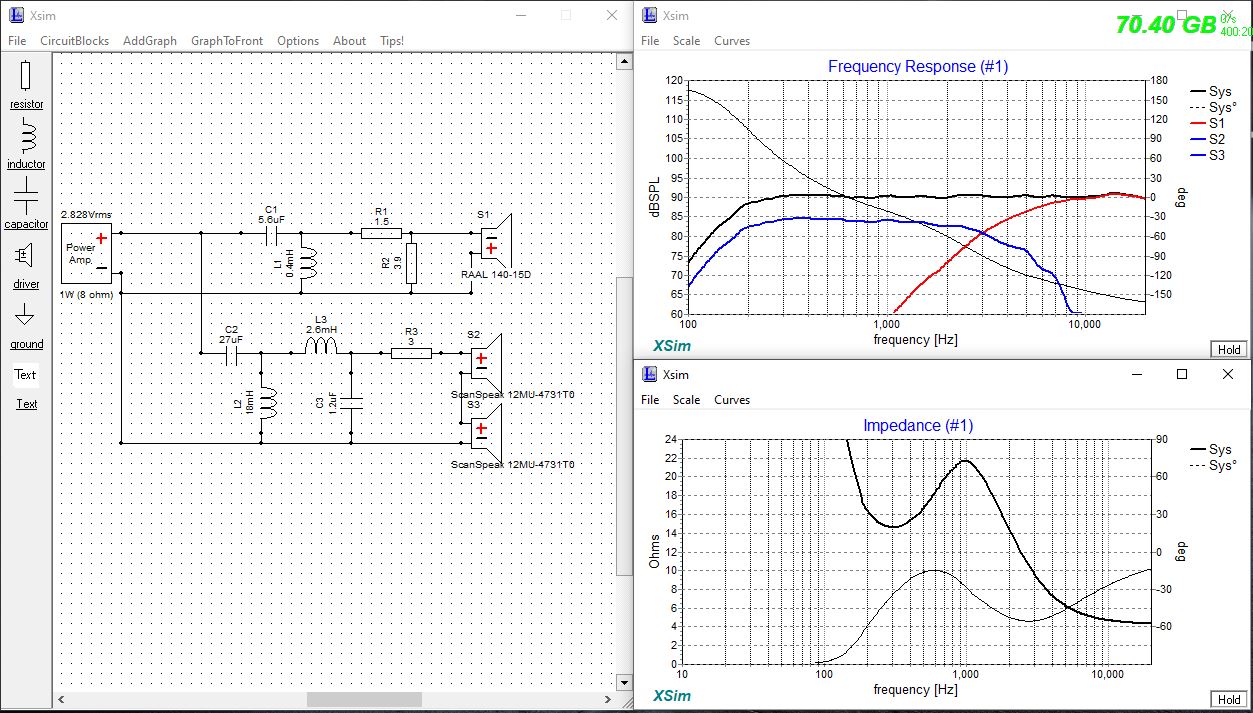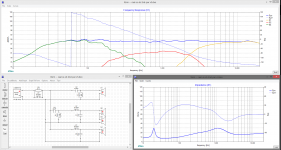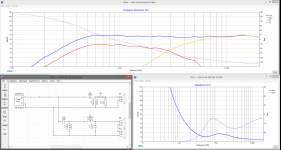You can do better than either for less.
Frankly though, using a mid. doubled-up and pushing it much below 200 Hz is asking for problems. The Illuminator mid. has higher odd-order distortion below 300 Hz. IF however you do use a sufficient high-pass (presumably active from MiniDSP), then it should be OK as long as you don't have really high output levels. The driver sounds really good above 400 Hz.
If I were going by this design: MTM sort, 2-way only with ribbon it would be:
crossover around 2.5 kHz, with 2 Zaph Audio ZA14W08's (in *parallel*) with a Viawave SRT-7:
Zaph Audio ZA14W08 | HiFiCompass
Viawave SRT-7 | HiFiCompass
Despite the lower linear xmax those Zaph drivers are tailor-made to that sort of *MTM 2-way design, the only real limitation (beyond ultimate spl) is getting the crossover right as far as dispersion (..and of course notching the bell mode resonance near 9 kHz).
Pocket the saved difference or plow it into your passive crossover components. 🙂 ..and enjoy a better loudspeaker.
*see ZA5.3 MTM
Zaph|Audio - ZA5 Speaker Designs with ZA14W08 woofer and Vifa DQ25SC16-04 tweeter
I don't think that is a better solution. Because you're pushing both drivers to it's frequency limits to make them meet. This will have a lot of resonance peaks arround the crossover frequency. With the Scanspeak/Raal combo you have more space to put the crossover, and less peaks wich gives a more flat and in phase response and impendance. About that distortion below 300Hz you're right, but then better find a sub that can high enough, in the last example i use a SB acoustic sub that can do that, i've adapted my rough draw for the CR so you can see that.
Attachments
Last edited:
I tweaked it a bit to use ScanSpeak 12MUs as Mids and clip them at around 200Hz.I went, just for the fun, a bit further with your id and added a subwoofer. The driver is the 12″ SB34NRX75-6 and i would put it in a 75L sealed box for this. That should give you an F3 of 36Hz and a F10 of 23Hz. And the crossover would be like this.
Just throwing arround with ID's. And again, this is a rough sketch, use it at own risk.

Is it the right thing to do or will it better to just let them roll off.
I tweaked it a bit to use ScanSpeak 12MUs as Mids and clip them at around 200Hz.

Is it the right thing to do or will it better to just let them roll off.
The high pass filter on the scanspeak looks ok, but i would not use a straight resistor on the midwoofer, if you need to attenuate it, use an L-pad like i use on the tweeter. It puts less heat on the resistors and attenuate smoother. And it's actually not needed, just optimise your curves a bit and the response is smoother
Attachments
The high pass filter on the scanspeak looks ok, but i would not use a straight resistor on the midwoofer, if you need to attenuate it, use an L-pad like i use on the tweeter. It puts less heat on the resistors and attenuate smoother. And it's actually not needed, just optimise your curves a bit and the response is smoother
That is great.
Now getting back to point, as I plan on using Sub-woofer for low end will it be better to clip the mid-woofer at 200Hz or should I let it be.
That is great.
Now getting back to point, as I plan on using Sub-woofer for low end will it be better to clip the mid-woofer at 200Hz or should I let it be.
Best is to build a sub that can go high enough to crossover it at 300Hz and use two standing under your left and right tmm speakers. You can do this active with a dsp or a analog active crossover. Or you can do it passive like i did in one of my examples above (but then your centerspeaker will also need a sub to keep up with the topsection).
The driver i've used, wich is fit for that is the very good 12" SB Acoustics SB34NRX75-6 in a 75L sealed box. it efficiency (90dB) and power (200w) makes it fit for active and passive crossovers, and it goes low in a sealed box (wich i like) But many other options are availeble if you like it different.
Using multiple subs will take up lot of space in my room. Instead I can go single large sub enough to cover entire room. Will it be fine.
Not if you crossover that high, so if you insist one one sub, you need a different bassmid driver that can go low enough (+/- 100Hz or lower) to avoid messing up your stereo image.
Below +/- 100Hz sound becomes omnidirectional and it does not matter for the stereo image where your sub is, above it does as sound becomes directional, and it's very important to keep all drivers close, in a +/- vertical axis. This is to avoid phase and timing issues. You can compensate that a bit with dsp, but not that much.
Below +/- 100Hz sound becomes omnidirectional and it does not matter for the stereo image where your sub is, above it does as sound becomes directional, and it's very important to keep all drivers close, in a +/- vertical axis. This is to avoid phase and timing issues. You can compensate that a bit with dsp, but not that much.
Yeah probably getting an mid-bass in 3-way is inevitable.Not if you crossover that high, so if you insist one one sub, you need a different bassmid driver that can go low enough (+/- 100Hz or lower) to avoid messing up your stereo image.
Below +/- 100Hz sound becomes omnidirectional and it does not matter for the stereo image where your sub is, above it does as sound becomes directional, and it's very important to keep all drivers close, in a +/- vertical axis. This is to avoid phase and timing issues. You can compensate that a bit with dsp, but not that much.
I think I should get started searching for a suitable driver. If you have any recommendation please do recommend. I am open for suggestions. Again looking for max 4" driver.
Yeah probably getting an mid-bass in 3-way is inevitable.
I think I should get started searching for a suitable driver. If you have any recommendation please do recommend. I am open for suggestions. Again looking for max 4" driver.
With all respect, but you are searching for the impossible. You want it small, low and loud at the same time, you can only choose 2 of those 3. A 4" that reach 100Hz in +/- 90dB efficiency does not exist, as this is physical impossible.
The closest you can get is a 6" i think, something like the SB Acoustics SB17NRXC35-4 or a FaitalPRO 6RS140. They go low enough, are efficient enough and will make it work to use a sub below 100Hz.
Yeah probably I should go up a notch but still only by 1" making it 5". Hope there are some decent drivers in that range. Not going up for 6" that will throw off the design aspect of the speakers.With all respect, but you are searching for the impossible. You want it small, low and loud at the same time, you can only choose 2 of those 3. A 4" that reach 100Hz in +/- 90dB efficiency does not exist, as this is physical impossible.
The closest you can get is a 6" i think, something like the SB Acoustics SB17NRXC35-4 or a FaitalPRO 6RS140. They go low enough, are efficient enough and will make it work to use a sub below 100Hz.
I don't think that is a better solution. Because you're pushing both drivers to it's frequency limits to make them meet. This will have a lot of resonance peaks around the crossover frequency. With the Scanspeak/Raal combo you have more space to put the crossover, and less peaks wich gives a more flat and in phase response and impendance. About that distortion below 300Hz you're right, but then better find a sub that can high enough, in the last example i use a SB acoustic sub that can do that, i've adapted my rough draw for the CR so you can see that.
Did you even look at Zaph's ZA5.3 MTM design? ..and remember, the spl in his graph is NOT showing baffle step compensation.
http://www.zaphaudio.com/ZA5/ZA5.3-FR-individual.gif
It has a higher Impedance peak around crossover (because he didn't add-in a filter for the inductive rise of the woofer and tweeter), but it does not have any resonant peaks. Go back and look at the CSD of the midbass at HiFi Compass. The only resonant peak higher in freq. is the bell-mode around 9 kHz, and as you can see in Zaph's design, it's notched-out.
The SRT-7 only has a resonance at fs, and it's well away from the crossover region.
In fact the SRT-7 is a better ribbon for this sort of design regardless of what midrange or midbass it's being used with.
A "sub" crossing-over at 300 Hz isn't a sub at all, it's a woofer that's part of a 3-way loudspeaker. Which is great as long as it's integrated properly with the loudspeaker. I'm all for 3-way loudspeakers (more than that even).
With all respect, but you are searching for the impossible.
He is, most do. 😱
..xmax and power is an issue as well (particularly relative to baffle-step compensation).
Last edited:
Did you even look at Zaph's ZA5.3 MTM design? ..and remember, the spl in his graph is NOT showing baffle step compensation.
http://www.zaphaudio.com/ZA5/ZA5.3-FR-individual.gif
It has a higher Impedance peak around crossover (because he didn't add-in a filter for the inductive rise of the woofer and tweeter), but it does not have any resonant peaks. Go back and look at the CSD of the midbass at HiFi Compass. The only resonant peak higher in freq. is the bell-mode around 9 kHz, and as you can see in Zaph's design, it's notched-out.
The SRT-7 only has a resonance at fs, and it's well away from the crossover region.
In fact the SRT-7 is a better ribbon for this sort of design regardless of what midrange or midbass it's being used with.
A "sub" crossing-over at 300 Hz isn't a sub at all, it's a woofer that's part of a 3-way loudspeaker. Which is great as long as it's integrated properly with the loudspeaker. I'm all for 3-way loudspeakers (more than that even).
Do I really need BSC when speaker is against the wall.
Wouldn't something like Dayton CF120-4 or Tang Band W4-1720 be sufficient to cover low end.With all respect, but you are searching for the impossible. You want it small, low and loud at the same time, you can only choose 2 of those 3. A 4" that reach 100Hz in +/- 90dB efficiency does not exist, as this is physical impossible.
The closest you can get is a 6" i think, something like the SB Acoustics SB17NRXC35-4 or a FaitalPRO 6RS140. They go low enough, are efficient enough and will make it work to use a sub below 100Hz.
Last edited:
Wouldn't something like Dayton CF120-4 or Tang Band W4-1720 be sufficient to cover low end.
They can get there on low volume in a ported cabinet (not a sealed), but you will have the same kind of distortion as the scanspeak has, because you push a driver to it's limits to make it meet the subwoofer. A 4" cone is not fit to go that low in that high efficiency (90dB), and will always distort way more than a bigger one. Then you better stay with the scanspeak and take the distortion with it.
I did the math, and did test it when i was living in a small appartment in Gent. But i ended up with a 10" woofer/subwoofer and a 6" FR after a failure build. I did try 3" FR and a 4"woofer didn't sound good. I used a Alpair 5.2 FR driver and the scanspeak 12W/4524G00 for that combo and the bass was blurry and boomy. At that time i used a B&W ASW 610 active subwoofer and it did not integrate well so i did sell those speakers to someone who recylced the drivers and used it with a 12" bass driver crossed over way higher (250Hz) wich did work. Since then i use a 6 (actually 5.5" with a big bezel) FR and a 10" woofer and sold the B&W, and that does the job way better. It's a cliche, but there is no replacement for displacement. A speaker needs to be a certain size to get low and loud on 1w.
Last edited:
They can get there on low volume in a ported cabinet (not a sealed), but you will have the same kind of distortion as the scanspeak has, because you push a driver to it's limits to make it meet the subwoofer. A 4" cone is not fit to go that low in that high efficiency (90dB), and will always distort way more than a bigger one. Then you better stay with the scanspeak and take the distortion with it.
I did the math, and did test it when i was living in a small appartment in Gent. But i ended up with a 10" woofer/subwoofer and a 6" FR after a failure build. U did try 3" FR and a 4"woofer didn't sound good. I used a Alpair 5.2 FR driver and the scanspeak 12W/4524G00 for that combo and the bass was blurry and boomy. At that time i used a B&W ASW 610 active subwoofer and it did not integrate well so i did sell those speakers to someone who recylced the drivers and used it with a 12" bass driver crossed over way higher (250Hz) wich did work. Since then i use a 6 (actually 5.5" with a big bezel) FR and a 10" woofer and sold the B&W, and that does the job way better. It's a cliche, but there is no replacement for displacement. A speaker needs to be a certain size to get low and loud on 1w.
What if I use two drivers in parallel. Will it still suffer.
Baffle will be max 6" away from the wall
Probably not, but you'll likely have some strange diffraction profile depending on how wide the baffle is (..the larger the better).
Still, you'll not be missing a great deal of pressure - and this will help considerably with your plan of the Scan Speak mid's (x2) in series. A high-pass (2nd) 150-200 Hz should be doable under this condition as long as you don't need spl above 98 db for any length of time.
Note though that the Scan Speak mid.s really only provide about 600 Hz higher low-pass than the Zaph driver (..2.5kHz vs 3.1kHz, and even then - the higher in freq. you go the worse the combing artifacts), but they do have lower odd-order distortion in the upper midrange/lower treble.
The Viawave ribbon is still the better ribbon for this design.
Here is the review from HiFiCompass (note the summary at the bottom):
Viawave SRT-7 ribbon tweeter | HiFiCompass
Last edited:
Isn’t a high x-over point a bad idea anyway with an MTM? That Raal is already 140mm, giving a C2C spacing of about 20cm, giving around 1700Hz.. to avoid lobing, you should cross below that.
-yes, the "combing" issue I mentioned.
It's a progressive effect (worse higher in freq.), and you can minimize it by off-setting the tweeter and pushing the 2 midbass's with their frames nearly touching together. You can even improve upon any diffractive effects from the tweeter in relation to the midbass drivers and the overall diffraction elements of the baffle/box/wall by making the midbass drivers horizontally off-set from each other.
ex. I8 (left) 8I (right), and the offset can help with a bit of delay for the crossover depending on the design and in relation to the listener. "I" = ribbon and "8" = two midbass drivers on top of each other (..vertical)
Lower freq. crossover is of course better, and a faster "slope" for the filter is also better.
It's a progressive effect (worse higher in freq.), and you can minimize it by off-setting the tweeter and pushing the 2 midbass's with their frames nearly touching together. You can even improve upon any diffractive effects from the tweeter in relation to the midbass drivers and the overall diffraction elements of the baffle/box/wall by making the midbass drivers horizontally off-set from each other.
ex. I8 (left) 8I (right), and the offset can help with a bit of delay for the crossover depending on the design and in relation to the listener. "I" = ribbon and "8" = two midbass drivers on top of each other (..vertical)
Lower freq. crossover is of course better, and a faster "slope" for the filter is also better.
Last edited:
- Home
- Loudspeakers
- Multi-Way
- Crossover for RAAL 140-15D x ScanSpeak 12MU-4731T0

